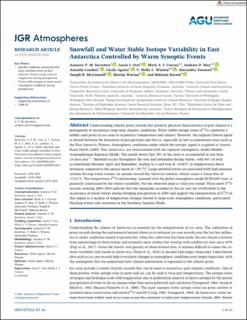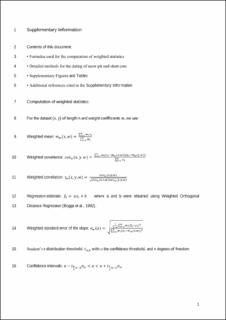| dc.contributor.author | Servettaz, Aymeric P. M. | |
| dc.contributor.author | Orsi, Anaïs | |
| dc.contributor.author | Curran, Mark A. J. | |
| dc.contributor.author | Moy, Andrew D. | |
| dc.contributor.author | Landais, Amaelle | |
| dc.contributor.author | Agosta, Cécile | |
| dc.contributor.author | Winton, V. Holly L. | |
| dc.contributor.author | Touzeau, Alexandra | |
| dc.contributor.author | McConnell, Joseph R. | |
| dc.contributor.author | Werner, Martin | |
| dc.contributor.author | Baroni, Mélanie | |
| dc.date.accessioned | 2021-06-24T11:07:25Z | |
| dc.date.available | 2021-06-24T11:07:25Z | |
| dc.date.created | 2020-12-14T11:44:20Z | |
| dc.date.issued | 2020 | |
| dc.Published | Journal of Geophysical Research (JGR): Space Physics. 2020, 125 (17), . | |
| dc.identifier.issn | 2169-9380 | |
| dc.identifier.uri | https://hdl.handle.net/11250/2761109 | |
| dc.description.abstract | Understanding climate proxy records that preserve physical characteristics of past climate is a prerequisite to reconstruct long-term climatic conditions. Water stable isotope ratios (δ18O) constitute a widely used proxy in ice cores to reconstruct temperature and climate. However, the original climate signal is altered between the formation of precipitation and the ice, especially in low-accumulation areas such as the East Antarctic Plateau. Atmospheric conditions under which the isotopic signal is acquired at Aurora Basin North (ABN), East Antarctica, are characterized with the regional atmospheric model Modèle Atmosphérique Régional (MAR). The model shows that 50% of the snow is accumulated in less than 24 days year−1. Snowfall occurs throughout the year and intensifies during winter, with 64% of total accumulation between April and September, leading to a cold bias of −0.86°C in temperatures above inversion compared to the annual mean of −29.7°C. Large snowfall events are associated with high-pressure systems forcing warm oceanic air masses toward the Antarctic interior, which causes a warm bias of +2.83°C. The temperature-δ18O relationship, assessed with the global atmospheric model ECHAM5-wiso, is primarily constrained by the winter variability, but the observed slope is valid year-round. Three snow δ18O records covering 2004–2014 indicate that the anomalies recorded in the ice core are attributable to the occurrence of warm winter storms bringing precipitation to ABN and support the interpretation of δ18O in this region as a marker of temperature changes related to large-scale atmospheric conditions, particularly blocking events and variations in the Southern Annular Mode. | en_US |
| dc.language.iso | eng | en_US |
| dc.publisher | AGU | en_US |
| dc.title | Snowfall and Water Stable Isotope Variability in East Antarctica Controlled by Warm Synoptic Events | en_US |
| dc.type | Journal article | en_US |
| dc.type | Peer reviewed | en_US |
| dc.description.version | publishedVersion | en_US |
| dc.rights.holder | Copyright 2020. American Geophysical Union. All Rights Reserved. | en_US |
| dc.source.articlenumber | e2020JD032863 | en_US |
| cristin.ispublished | true | |
| cristin.fulltext | postprint | |
| cristin.fulltext | postprint | |
| cristin.qualitycode | 2 | |
| dc.identifier.doi | 10.1029/2020JD032863 | |
| dc.identifier.cristin | 1859454 | |
| dc.source.journal | Journal of Geophysical Research (JGR): Space Physics | en_US |
| dc.source.40 | 125 | |
| dc.source.14 | 17 | |
| dc.identifier.citation | Journal of Geophysical Research (JGR): Space Physics. 2020, 125(17), e2020JD032863 | en_US |
| dc.source.volume | 125 | en_US |
| dc.source.issue | 17 | en_US |

